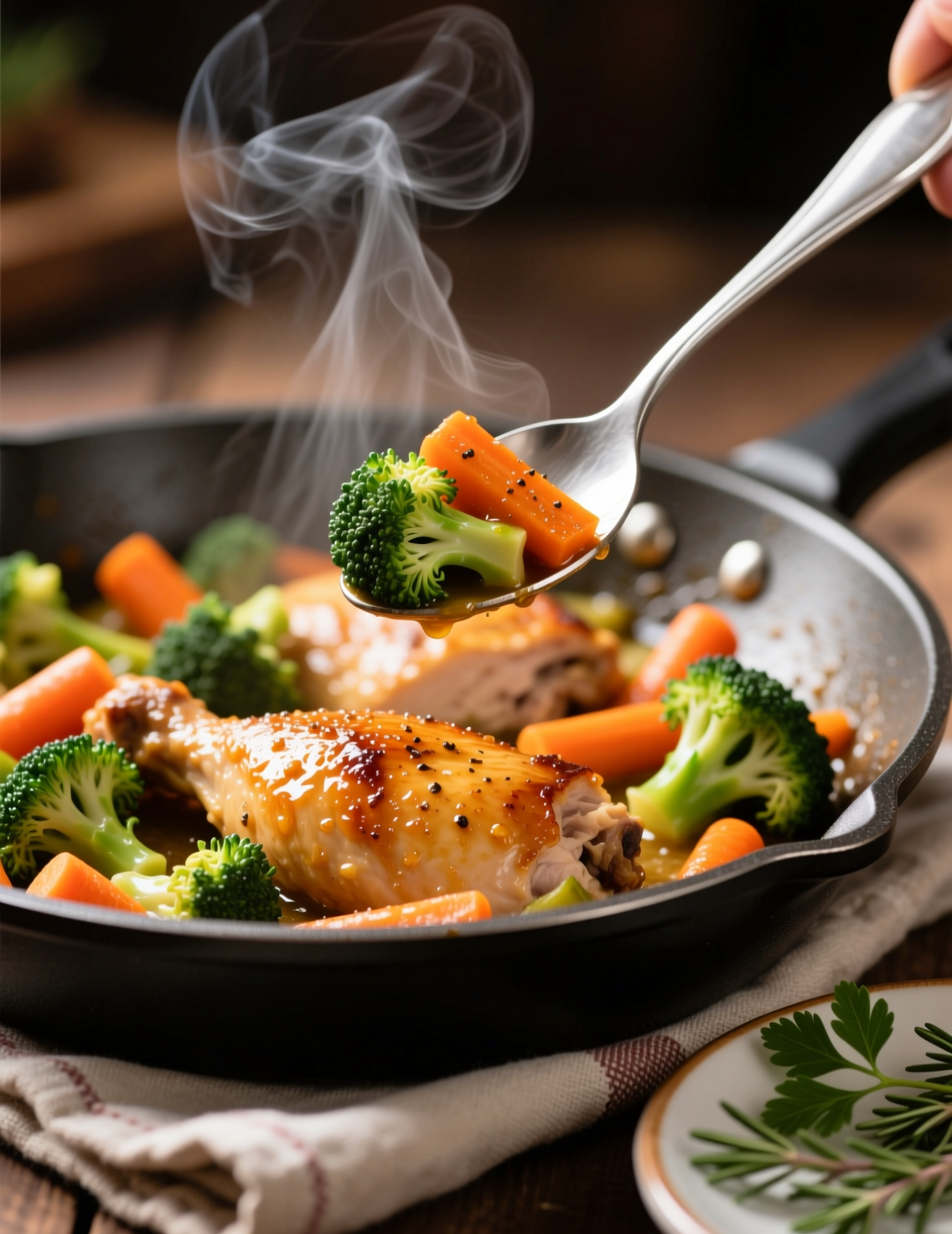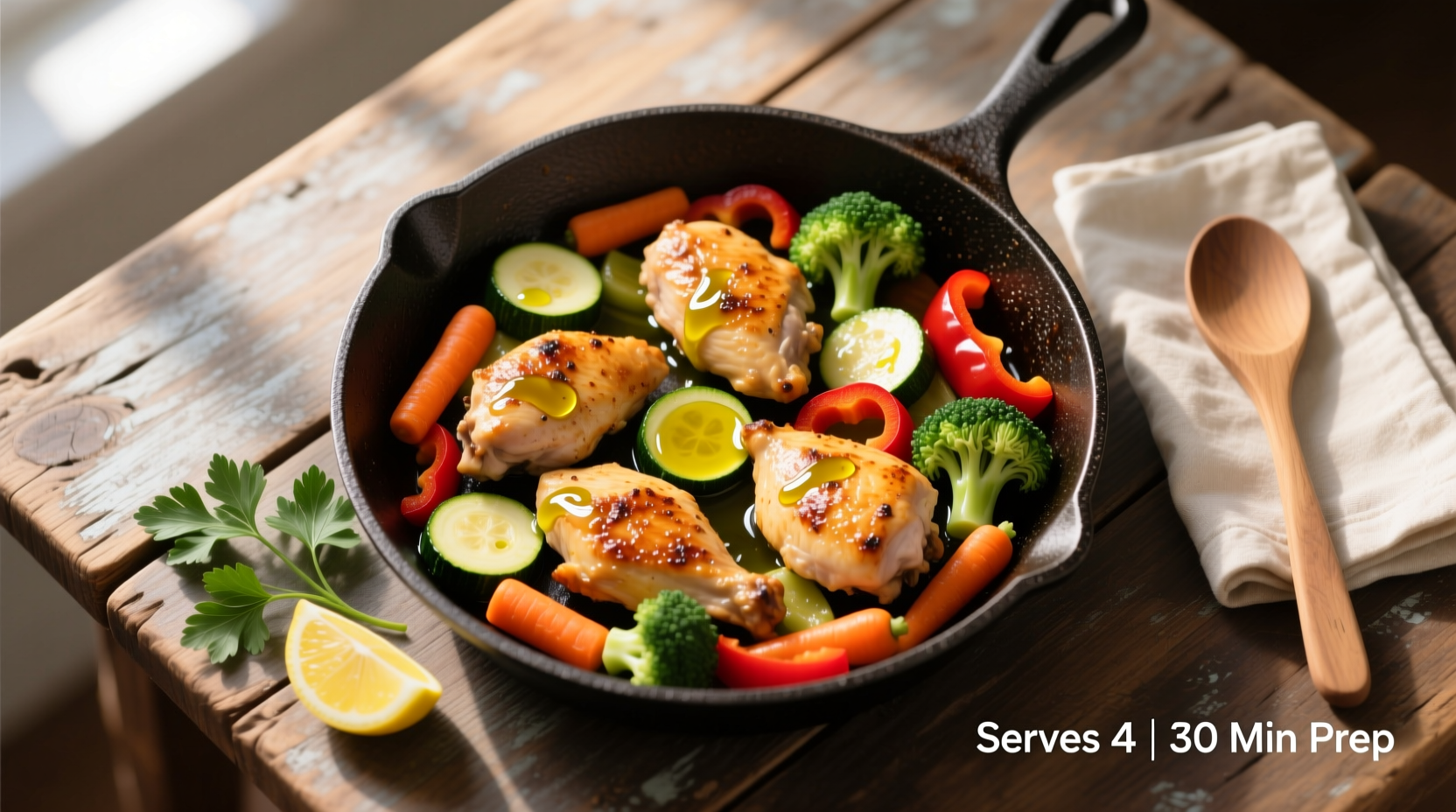A skillet of chicken and vegetables sounds almost too simple, doesn’t it? Yet, in kitchens worldwide, simplicity often hides the true art of cooking. The balance between protein and vegetables is one of the oldest tricks in the culinary world, and still, few manage to do it properly. This article is not just another recipe write-up—it’s a deep dive into technique, flavor science, nutrition, and how a single skillet meal can transform both the home kitchen and a professional service line.
Why the Chicken and Vegetables Skillet Matters
Chefs know this truth well: the skillet is unforgiving. It rewards sharp timing and punishes carelessness. Chicken, with its mild flavor, can swing either way—juicy perfection or dry disappointment. Vegetables, those stubborn little things, often cook at different rates, making balance tricky. The skillet brings these challenges into sharp focus.
Beyond technique, there’s also the story of value. A skillet dish is quick, cost-effective, and visually striking. In restaurants, this matters because presentation equals perception. At home, it’s about saving time while still offering nutrition that meets dietary needs. For a family of four, one skillet keeps cleanup minimal, and the flavors harmonize in ways that no separate pans could ever achieve.
Ingredients and Their Roles
Here’s the lineup for a balanced 4-serving portion:
- 1.5 pounds boneless, skinless chicken breasts or thighs
- 2 tablespoons olive oil (or a neutral oil with a high smoke point)
- 1 large zucchini, sliced into half-moons
- 1 red bell pepper, cut into strips
- 1 yellow bell pepper, cut into strips
- 1 medium red onion, sliced
- 1 cup broccoli florets
- 2 medium carrots, thinly sliced
- 3 garlic cloves, minced
- 1 teaspoon smoked paprika
- ½ teaspoon dried thyme
- Salt and black pepper, to taste
- ½ cup low-sodium chicken broth (or dry white wine for depth)
- Optional: squeeze of lemon or sprinkle of parmesan at the end
Professionals will immediately notice something here: balance in color, texture, and cooking time. Carrots and broccoli bring crunch. Bell peppers offer sweetness. Zucchini balances moisture. Garlic and onion layer aroma. This mix is not random—it is orchestrated.

The Science of Skillet Heat
The skillet is not a neutral surface. Cast iron retains heat, stainless steel spreads it, non-stick forgives mistakes but lacks deep browning. Heat management here is everything. At around 350°F, Maillard reaction works its magic, giving chicken that sought-after golden crust. Push it past 400°F, and your vegetables burn before softening.
In professional kitchens, line cooks rotate pans constantly, lifting off heat to control cooking without fiddling with knobs. At home, cooks often forget this dance and trust the dial too much. That’s why chicken turns rubbery or vegetables collapse into mush. Knowing when to remove the skillet from direct heat is as important as seasoning.
Step-by-Step Technique
- Prep first. Slice vegetables evenly. Uneven cuts ruin timing. Professionals often use a mandoline for precision.
- Season chicken generously. Paprika, thyme, salt, and pepper coat evenly. Let it sit for 10 minutes if possible, so flavors penetrate.
- Heat the skillet. Add oil until shimmering. Lay chicken down without crowding. That sear must be undisturbed for at least 4–5 minutes.
- Flip once. Cook until internal temp hits 160°F. Remove and let rest—carryover heat will finish it.
- Vegetables next. Start with carrots and broccoli since they take longest. Add onion and peppers after 3 minutes, zucchini last. Garlic always near the end, or it burns.
- Deglaze. Pour in broth or wine, scraping those browned bits. That’s concentrated flavor, not dirt.
- Return chicken. Let it mingle with vegetables for 2 minutes, absorbing juices. A quick squeeze of lemon brightens the whole dish.
This process takes no more than 25 minutes. But every second matters.
Nutritional Balance and Health Insights
This dish lands squarely in the “nutrient-dense” category. A single serving offers:
- ~35g protein (from chicken)
- ~9g fiber (from mixed vegetables)
- Vitamins A, C, and K in significant amounts
- Healthy fats from olive oil
According to USDA data, chicken breast remains one of the most efficient protein sources with low saturated fat content. Pairing it with fiber-rich vegetables regulates blood sugar response, which is vital for athletes and anyone monitoring energy levels. For professionals designing menus, this makes it an easy “fit” for health-conscious diners.
Common Mistakes in Skillet Cooking
Even skilled cooks slip up with skillet meals. The most common? Overcrowding. Once moisture builds, browning becomes impossible, and you steam instead of sear. Another is seasoning too late. Salt must touch raw chicken to draw moisture, helping crust formation.
Some think vegetables should be tossed in all at once. Wrong. This creates a mess of half-cooked carrots and limp zucchini. Staggering entry times is the chef’s way. Lastly, fear of high heat ruins more skillets than anything. Heat is your ally—hesitate, and you lose caramelization.
Trends in One-Pan Meals
Globally, demand for one-pan meals has grown. Data from the International Food Information Council shows that 67% of consumers prefer meals that require fewer dishes. The rise of “weeknight skillet” recipes online proves this isn’t slowing down. Professional kitchens also lean on skillet-style plating, not always because of efficiency, but because rustic, family-style presentation feels authentic.
Chefs now experiment with global flavors inside skillet dishes. A chicken-vegetable skillet with harissa in North Africa. Soy-ginger marinades across Asia. Even Latin American spices like cumin and chipotle. The versatility makes it timeless.
Flavor Building: Going Beyond Basics
A professional trick is layering flavors. Toasting spices in oil before adding chicken deepens aroma. Adding broth in stages instead of all at once builds complexity. Finishing with acid—be it lemon, vinegar, or even a splash of balsamic—balances richness.
Texture is another battlefield. A sprinkle of toasted nuts, seeds, or cheese on top adds crunch. These small touches separate a “good enough” skillet from a memorable one. Restaurants rely heavily on these finishers because they elevate perceived value without adding cost.
Variations for Professionals
- Mediterranean Skillet: Swap broth for dry white wine, finish with olives and feta.
- Asian-Inspired: Soy sauce, ginger, sesame oil, and bok choy in place of zucchini.
- Spicy Latin Twist: Chipotle, cumin, black beans folded into the mix.
Each keeps the core method intact, yet reshapes the dish for different palates. Menu planners love this flexibility—it’s one template with endless revenue streams.
Storage and Meal Prep Insights
From a service perspective, this dish doesn’t hold for hours under a heat lamp. Vegetables soften too much. But it does reheat well if cooled properly and stored airtight. Professionals follow the 2-hour rule: cool within two hours, refrigerate below 40°F.
For home cooks, leftovers last 3 days easily. Adding a splash of broth when reheating revives texture. In catering settings, partial cook methods work—undercook slightly, then finish onsite for fresh flavor.
Expert Recommendations
- Invest in a heavy skillet. Thin pans lead to hot spots, which ruin searing.
- Respect the sequence of vegetables. Think of them as a choir, not a solo act.
- Don’t fear acid at the end. Lemon is not garnish—it’s chemistry.
- Always rest chicken. Those juices will betray you if you slice too soon.
Final Thoughts
A Chicken and Vegetables Skillet may appear simple on the surface, but the depth of technique, science, and artistry behind it is undeniable. For four servings, it’s practical, nutritious, and adaptable across cuisines. More than that, it teaches cooks—whether home enthusiasts or professionals—the fundamentals of timing, seasoning, and balance in a single pan.
Cooking this dish right isn’t about following steps blindly. It’s about listening to the sizzle, smelling the garlic just before it turns bitter, and knowing by instinct when to pull the chicken off the heat. That’s where true mastery hides—in the moments you can’t write down in a recipe card.
FAQs
What skillet works best for chicken and vegetables?
A heavy cast iron or stainless steel skillet works best for even heat and good sear.
How long does it take to cook the dish?
Around 25 minutes from start to finish, including prep and cooking.
Can I use chicken thighs instead of breasts?
Yes, thighs add more flavor and stay juicier than breasts.
Do I need to marinate the chicken first?
Not required, but seasoning 10 minutes before cooking improves flavor.
Why should vegetables be cooked in stages?
Because each vegetable has different cooking times and textures.
Can I substitute the chicken broth?
Yes, use dry white wine, vegetable stock, or even water with herbs.
How do I prevent the chicken from drying out?
Sear on high heat, don’t overcook, and always rest before slicing.
What vegetables can I swap in this recipe?
Green beans, mushrooms, asparagus, or snap peas work perfectly.
How should I reheat leftovers?
Gently reheat in a skillet with a splash of broth to revive flavors.
Is this dish healthy?
Yes, it’s protein-rich, high in fiber, and packed with vitamins.
Can I meal prep this skillet for the week?
Yes, it keeps well for 3 days in the fridge when stored properly.
Do I really need to deglaze the pan?
Yes, it lifts flavorful browned bits that deepen the sauce.
Can I add cheese at the end?
Absolutely, parmesan or feta adds richness and contrast.
Is this recipe kid-friendly?
Yes, just reduce spices or swap seasonings for milder ones.
What’s the secret to perfect flavor?
Layer spices, deglaze well, and finish with a squeeze of lemon.

Mariana is a passionate home cook who creates delicious, easy-to-follow recipes for busy people. From energizing breakfasts to satisfying dinners and indulgent desserts, her dishes are designed to fuel both your body and hustle.
When she’s not in the kitchen, she’s exploring new flavors and dreaming up her next recipe to share with the Foodie Hustle community.

